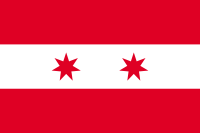Republic of Baja California
| Republic of Lower California | ||||||||||
| República de Baja California (Spanish) | ||||||||||
| Unrecognized state | ||||||||||
| ||||||||||
|
| ||||||||||
.svg.png) Location of Lower California territory on 1824 map | ||||||||||
| Capital | La Paz | |||||||||
| Government | Republic | |||||||||
| President | William Walker | |||||||||
| History | ||||||||||
| • | Established | November 3, 1853 | ||||||||
| • | Disestablished | January 21, 1854 | ||||||||
| Area | ||||||||||
| • | 1853 | 143,390 km² (55,363 sq mi) | ||||||||
| ||||||||||
The Republic of Baja California was a proposed state from 1853 to 1854, after a failed attempt to invade Sonora from the Arizona border. William Walker coveted appropriate Sonora, and their claims had the support of tycoons and some government complacency in the United States. In November 1853 he embarked with two hundred men to La Paz, where he could capture the political head and proclaim the independence of the "Republic of Baja California", a state that never had recognition nor truly existed because Walker had neither full control of the peninsula nor the support of the population. Rather, he faced resistance from the Mexican army and civilians, among a group led by Antonio Meléndrez. In spite of being replicated in Ensenada and suffer the mutiny of his troops from the United States, Walker president of the Republic of Sonora, which also included Baja California was proclaimed and, like its successor, was not there in fact or endorsement. In fact, Walker only reached the territory of Sonora in 1854 and when pressured by the US Navy had to flee Mexico Ensenada. Meléndrez to harassment and desertion from another part of his troops, Walker and the remnants of his army surrendered filibuistero San Diego in the US military. Brought to trial, the judge said he was guilty of violating the Neutrality Act signed between Mexico and the United States after the US invasion of Mexico in 1847 however, Walker was acquitted by the jury.
History
William Walker was an American physician and adventurer who had settled in California during the gold rush. He had tried to take over the state of Sonora before launching the campaign of Baja California, which had the support of American magnates probably among them was William Vanderbilt; and within the framework of the omission of the California authorities to what was an illegal action against a foreign country.

Walker started from California, in the company of a group of 45 American mercenaries, on October 17, 1853, with the intention of arriving at Guaymas (Sonora) and occupy the Mexican state. However, one year before the Mexicans had already repelled an expedition of French filibusters, an increase of troops and military preparedness. Perhaps this made Walker refrain, who chose to attack and take the first California peninsula as a first step to seize Sonora. Aboard the schooner Caroline Walker's expedition arrived at Cabo San Lucas on October 28 of that year. He moved by sea to La Paz, capital of Baja California territory, which occupied five days after the capture Rafael Espinosa, political head of the territory. There, the Mexican flag filibusters hauled down the Mexican flag and hoisted in place a flag of three horizontal stripes, two red and a white center, charged two stars representing Baja California and Sonora.[1] on 3 November of 1853 and the mercenaries proclaimed the independence of the peninsula which they called the Republic of Baja California. Later, the expedition captured Colonel Juan Climaco Rebolledo, who came to replace Espinosa in the office of a political leader without knowing that the Baja California capital had been taken by the American invaders.

Since the expedition of reinforcements from California were slow in coming, Walker decided to move its headquarters to the north of the peninsula, near the border with US and the land passage to Sonora, which was the goal of their ambitions and also the US government, which had already expressed its intention to buy northwestern Mexico. In La Paz there were some clashes between civilian residents and filibusters, Walker played as military victories over the Mexican government, which he accused of being tyrant and decadent. And in Ensenada, the filibusters established their headquarters in what is now the Third and Gastélum streets of that city [2] From there, Walker issued a proclamation to the American people, requesting their support to defend the independence of Baja California, which had self-appointed president. Many American volunteers joined the call of Walker to add a number of 253 climbers who arrived in Ensenada on the boat Anita .
See also
- Baja California (disambiguation)
- Filibustering expeditions in Mexico
Notes
References
- Olmeda García, María del Pilar (2010). Baja California. Historia de las instituciones jurídicas. Ciudad de México: Instituto de Investigaciones Jurídicas UNAM.
- Rosengarten, Frederic (2002). William Walker y el ocaso del filibusterismo. Tegucigalpa: Guaymuras.